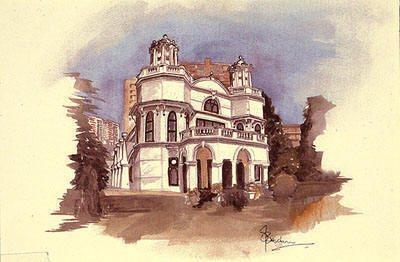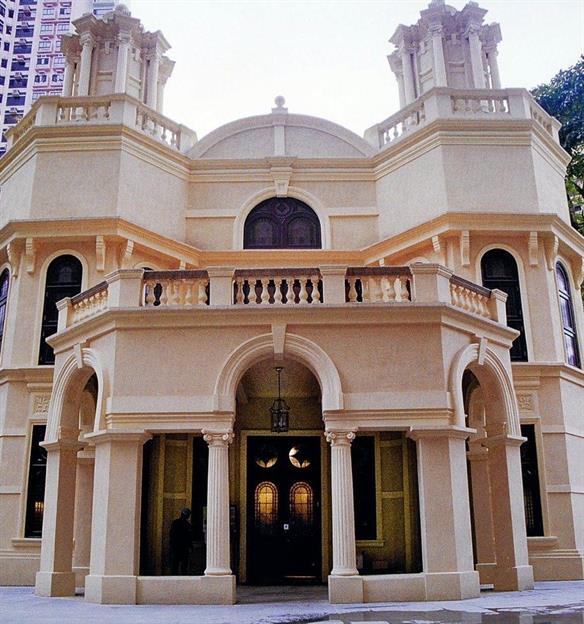The Ohel Leah Synagogue, Hong Kong
by Erica Lyons
Erica Lyons is the publisher and managing editor of Asian Jewish Life magazine. She contributed this article for the website of ANU Museum (August, 2011)
The construction of Ohel Leah Synagogue (OLS) began with the laying of the foundation stone on 7 August 1901 by Abraham Jacob Raymond in a project initiated by the Sassoon brothers, Jacob, Edward and Myer. The initial structure was completed in early 1902 and named to commemorate the Sasson brothers’ mother Leah. It was built in colonial style and incorporated elements from the Edwardian free classical-style. The exterior is flanked by two impressive octagonal towers. The interior of the synagogue was based on a simple rectangular basilica plan with a relatively open floor plan. Polished Aberdeen granite columns, a central elevated bimah enclosed by carved wood balustrades on three sides, and heavy, rich wood benches include a number of elements reflective of its Baghdadi/ Sephardi heritage. The women’s gallery, located on the second storey, runs along three sides of the hall.
Due to significant wear and tear over nearly a century, as well as a series of ad hoc additions and alterations, the decision was made to embark on a large scale restoration and conservation program. The project commenced in 1996 and was completed in 1998. A formal rededication ceremony was held on October 18, 1998. The project received an Outstanding Project Award in the inaugural UNESCO Asia-Pacific Heritage 2000 Awards.
The synagogue today serves Hong Kong’s Modern Orthodox community. OLS follows Nusach Sephardi (Ashkenazi Nusach incorporating some Sephardi customs). The Synagogue staff includes both a rabbi and a youth rabbi. Inside the synagogue’s compound, there is also the Hong Kong Jewish Community Centre, the community’s preschool and the Mikveh.
Ohel Leah Synagogue, Hong Kong, 2011 (Courtesy of Erica Lyons)
Rosh Hashanah greetings card showing
Ohel Leah Synagogue in Hong Kong
The Oster Visual Documentation Center, ANU – Museum of the Jewish People
The Jewish Community of Hong Kong
Erica Lyons
Publisher and managing editor of Asian Jewish Life magazine She contributed this article for the website of Beit Hatfutsot. August, 2011
Hong Kong has long been established as a great port and financial center of world importance. From 1842 until June 30 1997 it was a British crown colony. It is now, along with Macau, one of two Special Administrative Regions (SAR) of the People’s Republic of China. The HKSAR falls under a governmental policy of “one country, two systems”.
With respect to the earliest Jewish residents, the Sassoon family arrived at Hong Kong when it was ceded to Great Britain by China in 1842. They transferred their offices from neighboring Canton to Hong Kong and helped to develop this new port.
The Hong Kong Jewish Community was formally established in the 1850s though the early community operated mainly in premises leased by the Sassoon family. The first synagogue, the Ohel Leah synagogue, built by Sir Jacob Sassoon, was opened in 1902. The Jewish cemetery was dedicated in 1855The Jewish population numbered 60 Sephardim in 1882; 100 in 1921, mainly Sephardim; 250 in 1954, half Sephardim and half Ashkenazim; 230 in all in 1959; and 200 in 1968, 70 Sephardim and 130 Ashkenazim.
From the 1960’s onwards, Hong Kong’s development as a trade and finance centre has attracted tens of thousands of foreigners, among them Jews from the US, Israel, the UK, Australia and Canada. They revitalized the local Jewish community. In 1997, 2,500 Jews were living in Hong Kong, two thirds of them Americans and Israelis.
The current Jewish community’s population, as of 2010, is estimated to be approximately 5,000 and is comprised of mainly expatriates originating from countries that include UK, US, France, Australia, South Africa, Israel and Canada who worship in seven congregations. In addition to the Ohel Leah Synagogue, there is a reform congregation, the United Jewish Congregation, established in 1988 to serve Hong Kong’s Reform, Liberal and Conservative Jews. There are Chabad Houses on Hong Kong Island, Kowloon and the newest centre on Lantau Island. There are also two Sephardi Orthodox congregations, Kehilat Zion in Kowloon, and the smaller Shuva Israel congregation on Hong Kong Island.
The Ohel Leah Synagogue complex also houses the community’s mikvah and the Jewish Community Centre (JCC), the epicenter of Jewish communal life in Hong Kong. The Centre was built in 1995 to replace the older Jewish Recreation Club or JRC as it was better known. As well as providing extensive communal programming that covers a spectrum of interests from recreational, athletic, academic and cultural, the JCC also boasts a Judaic library and Sino-Judaic archive with a fulltime librarian, meat restaurant, dairy restaurant, coffee corner, large multipurpose function room, kosher market, indoor swimming pool and gym.
In addition to the JCC’s two glatt kosher restaurants, Sabra Coffee Shop (Meat) and the Waterside (dairy), and full catering/banqueting services, kosher food is also available at Kehilat Zion’s Mul Hayam Restaurant, in Kowloon, and Shuva Israel’s restaurant in Hong Kong’s Central business district.
Jewish life in Hong Kong includes a number of other organizations that further enrich the community experience. The Jewish Women’s Association of Hong Kong, initially established in the 1940s to provide aid to the Jewish refugees arriving from Shanghai, annually provides a number of cultural, social and educational programs as well as fund raising efforts aimed at aiding charitable organizations in Israel as well as the local Hong Kong community.
The Jewish Film Festival provides annual programming with a two week festival drawing large audiences from within the community as well as the broader local Hong Kong community.
The Jewish Historical Society of Hong Kong (JHS) was founded in 1984, following a lecture by Mr. S.J. Chan at the former Jewish Club. The initial aims of the JHS, an informal Society, were to establish a Judaica library for the HK Jewish community, within which would be housed the Sino-Judaic collection; to promote Sino-Judaic co-operation; to thoroughly document the existing records of the Community and to publish on the subject.
Projects recently undertaken by the JHS include recording, photographing and translating the 300 headstones in the HK Jewish cemetery, and an ongoing series of taped interviews of the personal experiences and family histories of members of the Jewish community.
Connection to Israel
The Jewish community is strongly tied to Israel. In 1958, businessman Victor Zirinsky was appointed Israel’s Honorary Consul in Hong Kong and served until Israel’s diplomatic presence was formally established with the appointment of a Consul General as the representative for both Hong Kong and Macau in 1985. Formal diplomatic relations were established between China and Israel in 1992.. Today, in addition to Hong Kong, Israel also operates Consulates in Shanghai and Guangzhou and an Embassy in Beijing.
The community’s ties to Israel also include Tzofim (Israeli Scouts). This local branch of the Israeli youth movement was established in 2010. The Israeli Consulate runs an Israeli Film Festival every three years and there are both youth and adult Maccabbee soccer teams. The community also actively participates in programming for and the support of Keren Hayesod-United Israel Appeal (UIA).
Yom Haatzmaut and Yom Hazikaron are pivotal dates on the communal calendar and marked by large scale events. Likewise, annually there are numerous organized activities in support of United Israel Appeal and Jewish National Fund.
The Jewish Cemetery
The Jewish Cemetery of Hong Kong is located in Happy Valley, surrounded now by high rise apartment blocks, with the entrance flanked on either side by a Buddhist temple and its school. The cemetery, dedicated in 1855 and formalized in 1858 by a 999-year Crown Colony lease, is one of the few Jewish cemeteries in the Far East that remains in its original 19th century location and still in use.
The earliest burial, of a Mr. Leon Bin Baruel, is dated 1857. The Chevra Kadisha list shows that most of those who died in the early years were single men, as it was not common to bring wives and families to live in Hong Kong at the time.
In 1904, during the tenure of Sir Matthew Nathan, Hong Kong’s only Jewish governor, the lease on a piece of land adjoining the cemetery was granted by the Crown, this time on a seventy-five year lease – which was renewed for a further seventy-five years in 1979. The chapel, Tehora room, and the other small buildings in the cemetery are believed to date from the period of the new land grant.
The gravestones are mostly in Hebrew and English, but Arabic, Russian and Dutch can be found as well. There are ornate Sephardi headstones as well as simple Ashkenazi stones, each one representing a different culture and time period.
There are approximately 360 graves in the cemetery.
Education
Founded in 1991, the Carmel School Association has quickly grown from a playgroup of a dozen children into one of Hong Kong’s leading international schools, providing the highest standard of Jewish and secular Education. It is, to date, East Asia’s only Jewish day school offering a secondary education program.
After several moves, the School is now based on three campuses. The Jewish Community Centre campus houses the preschool children ages one to five. Also in the Mid-Levels area of Hong Kong, the Borrett Road Campus houses the Elementary school for US Grades Kindergarten through Grade Five. The newly established Elsa High School, is located Shau Kei Wan, on the east side of Hong Kong Island.
The various Synagogues offer after-school Jewish education alternatives, including the UJC’s well established Shorashim program.

